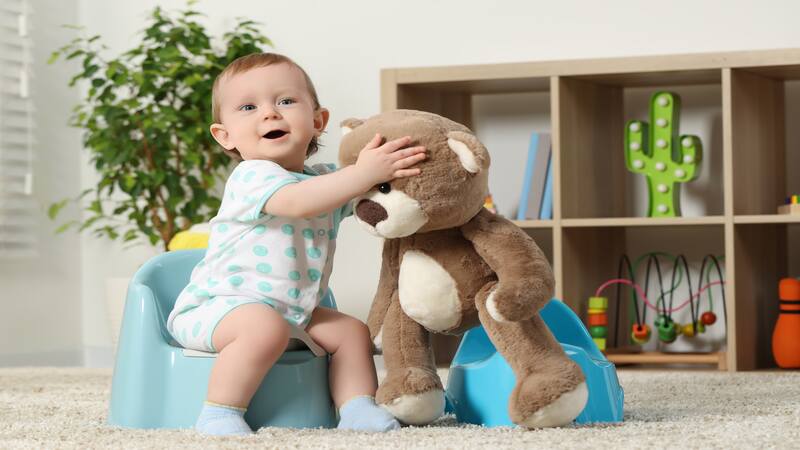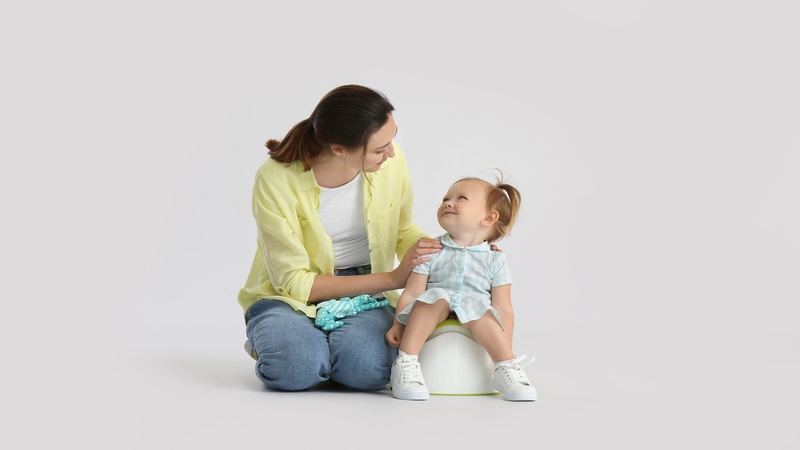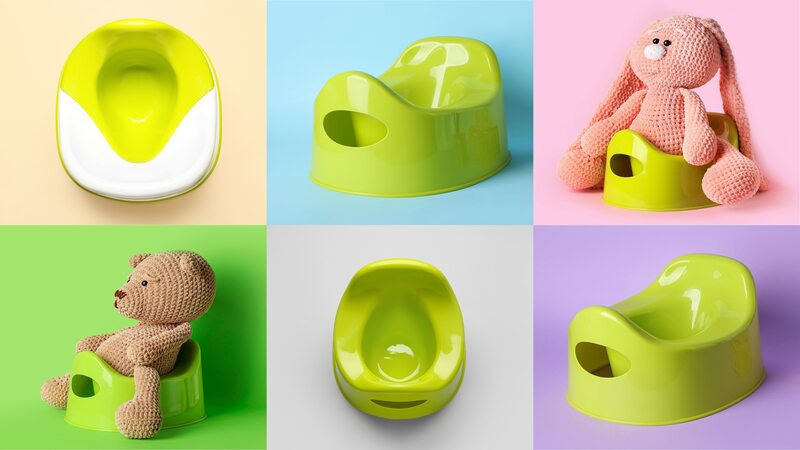
Parents are generally eager to get their kids potty trained – which marks the end of diaper-changing routines. Potty training is one of the most grueling tasks that you would face while helping your toddler grow into an adult. Kids are expected to use the toilet seat once they reach around 18 months. The total length of the training would vary, but it should take at least a couple of months for your toddler to learn to use the toilet without any help.
While potty training your toddler, the following steps may prove effective. At the same time, you would do well to improvise and identify areas that your toddler would respond to.
The 10 Basics of Potty Training
Potty training is a challenging phase for both you and your toddler. These tips will surely come in handy to navigate this phase easily-
1. Knowing When to Start

There is no definite time regarding when to start potty training your toddler. But you should begin thinking of it once the first birthday has passed. Do not leave it too late and neither start it too early. Typically, an 18-month-old starts to identify when their bladder seems full (1).
Also, assess if the toddler can follow instructions, and can walk and sit on their own. Can they take off their bottoms? Are they able to gesture when the urge strikes? All these factors will determine whether your toddler is ready or not.
Additionally, do assess yourself as well – will you be able to give your toddler the patience and time? If any of you is going through a difficult phase, it is better to postpone it a bit.
2. Sticking to a Schedule
The first thing that you as a parent need to do is to set a schedule. To begin with, make your toddler sit on the potty seat with clothes on – at a time when they are likely to pass bowels. Slowly, transition from clothes to bare bottoms. Explain to the toddler that this is how all adults do it. However, if your kid feels uncomfortable, leave it there and then. Never force your toddler to do anything, as it can hamper the process negatively (2). It is better to postpone the training to some other convenient time.
3. Patience And Time
Be patient and take ample time. Start slowly by setting up a once or twice-a-week schedule. Then it can gradually be increased to three and eventually for every day of the week. Do not begin the process if you or the toddler are drained emotionally or physically. A new job, change of house, separation etc. are some situations where you should avoid starting potty training (3). It would be in the best interest to start sometime later in such a situation.
4. Get The RIGHT Toilet Seat

The next important step is to purchase the toilet seat. Now, you need to make your toddler a part of selecting the potty equipment for themself. Encourage the toddler to pick up their favorite color, while ensuring that it is comfortable and easy to clean. If shopping for a boy, go for ones that come without a urine guard or with a removable option. This will ensure that the guard will not cause any harm to the boy’s penis, which will ensure that he is not scared away from the equipment (4).
5. Set The Toilet Seat in The Bathroom
This would help set the environment. Make sure that the toilet is clean and hygienic as toddlers try to be fidgety and may touch or play around with other things in the bathroom (5). This can also be done after your toddler starts feeling comfortable in the toilet seat. In the context of potty training, these stimulants would help your kid know when to urinate or poop.
6. Refrain From Forcing
It is okay if your toddler fails initially. Do not try and force your toddler to complete their business in the stipulated time window. Allow your toddler the flexibility to evaluate, understand, and practice. They are little beings in the making, and forcing can scare them off and you may have a tougher time ahead. Restraining toddlers always does more harm than good, so let it go and try some other time.
7. Rewards

An extra bedtime story, verbal praises, appreciation or a reward like an ice cream treat or a visit to a place that your toddler loves would be a great stimulant. It would provide a sense of purpose for your toddler. Be sure to appreciate it even when the kid fails. It is the efforts that matter.
8. Accidents? Oh Yeah!
After toilet training of your toddler has begun, do not expect them not to have the occasional accident. Be prepared for it until they are fully trained. Temporary setbacks are pretty normal and a toddler typically has several accidents before they learn to keep themself dry all day. An accident does not imply you or your kid have failed, refrain from getting upset or shouting at the toddler. They are still learning to control the urges and understand why it is required to use a potty.
9. Night Training
You can also initiate night training when toddlers can largely keep themselves dry during the day. Tell them to continue the diaper but call for mommy if they feel the urge and need to use the potty. Ditching the diaper will need to be a slow, gradual process and may take quite a few months. Also, make the tot use the bathroom the first thing when they get up in the morning.
10. Encourage a Healthy Diet

A smooth bowel movement and regular toilet procedures are dependent a lot on the diet. Include a lot of water and roughage in the diet. A healthy diet can go a long way to help your toddler have a smooth bowel movement all their life (6).
Most parents want to initiate the potty training process, but not all are prepared for the challenges that follow. Patience and time are the keys, and in general, the younger the toddler is, the longer it takes to potty train them. In the initial phases of life, an infant knows little about toilet procedures. As they grow older, the need to be trained to manage one’s toilet routine becomes important. Potty training is a vital part of your toddler’s life. A well-developed habit would save your kid from countless inconvenient situations and help them develop into a healthy individual.
FAQ’s
1. What is The Best Advice For Potty Training?
The best advice for potty training your toddler is to let them get used to the potty chair. You can place it in your bathroom and let your toddler play with it, or sit on it. By doing this it will be easy for you to teach them potty training lessons.
2. Is it OK to Potty Train Slowly?
Yes, it is ok if your toddler learns potty training slowly. Kids can take a few weeks to several months to learn potty training.
3. Can I Potty Train in One Day?
No, your kid is not a robot where you can install a new program overnight. Toddlers will take time to learn this massive milestone and you will have to be patient.
References
- Toilet learning: Anticipatory guidance with a child-oriented approach. Paediatr Child Health. 2000 Sep;5(6):333-44. doi: 10.1093/pch/5.6.333. PMID: 20177551; PMCID: PMC2819951. – https://www.ncbi.nlm.nih.gov/pmc/articles/PMC2819951/
- Sanvictores T, Mendez MD. Types of Parenting Styles and Effects On Children. [Updated 2022 Sep 18]. In: StatPearls [Internet]. Treasure Island (FL): StatPearls Publishing; 2024 Jan – https://www.ncbi.nlm.nih.gov/books/NBK568743/
- Adapted from American Academy of Pediatrics Guide to Toilet Training, 2nd Edition (Copyright © 2016 American Academy of Pediatrics) – https://www.healthychildren.org/English/ages-stages/toddler/toilet-training/Pages/Emotional-Issues-and-Bathroom-Problems.aspx
- Wilder, David & Hodges, Ansley. (2017). Problems Associated with Toilet Training. 10.1007/978-3-319-62725-0_6. – https://www.researchgate.net/publication/320105016_Problems_Associated_with_Toilet_Training
- The National Health Service – https://www.cambspborochildrenshealth.nhs.uk/child-development-and-growing-up/hygiene/hygiene-for-toddlers-and-children/
- National Institute of Diabetes and Digestive and Kidney Diseases – https://www.niddk.nih.gov/health-information/digestive-diseases/constipation-children/eating-diet-nutrition


1 Comment
Nice tips.
you should also mention about right potty equipments as well